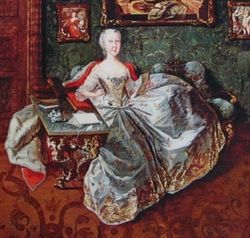Wappen Grafschaft Sachsen-Lauenburg
Formát:
951 x 1001 Pixel (121527 Bytes)
Popis:
The coat of arms of
Duchy of Saxony, Angria and Westphalia (Lauenburg) as used between 1435 and 1507 and again between 1671 and 1689. It shows in the upper left quarter the
Ascanian barry of ten, in
or and
sable (starting with the wrong colour in this copy), covered by a crancelin of rhombs (they are not shown in this undetailed copy) bendwise in
vert. (The
House of Wettin also adopted the barry of ten with the crancelin as its coat-of-arms, when it gained
Saxe-Wittenberg, which is why the barry reappears in the arms of many (formerly) Wettin-ruled states.) The crancelin symbolises the Saxon ducal crown. The second quarter shows in
azure an eagle crowned in or (crown missing in this copy), representing the imperial
County Palatine of Saxony. The third quarter displays in
argent three water-lily leaves in
gules, standing for the
County of Brehna. The lower right fourth quarter shows in sable and argent the electoral swords (Kurschwerter) in gules, indicating the Saxon office as
Imperial Arch-Marshal (German:
Erzmarschall, Latin:
Archimarescallus), pertaining to the Saxon privilege as
prince-elector, besides the right to elect a new emperor after the decease of the former. The Lauenburg branch duchy adopted this coat-of-arms, used before by the other brach duchy
Saxe-Wittenberg until its extinction in 1422, in order to enforce its failed claim to succession in Saxe-Wittenberg. Thus the different quarters of the coat of arms, from then on representing the
Duchy of Saxony, Angria and Westphalia (Lauenburg), were later often misinterpreted as symbolising
Angria (Brehna's water-lily leaves) and
Westphalia (the comital palatine Saxon eagle).
Více informací o licenci na obrázek naleznete zde. Poslední aktualizace: Sat, 19 Apr 2025 04:20:55 GMT
Relevantní obrázky
Relevantní články
Julius Jindřich Sasko-Lauenburský
Julius Jindřich Sasko-Lauenburský byl vévoda sasko-lauenburský, císařský vojevůdce, Askánec, vlastník řady panství včetně panství Zákupy.
.. pokračovat ve čtení
Seznam států na říšském sněmu v roce 1792
Tato stránka obsahuje seznam říšských stavů, zasedajících na sněmu Svaté říše římské v roce 1792, těsně po vypuknutí války s revoluční Francií a císařské volbě Františka II.
.. pokračovat ve čtení
Luisa Hesensko-Kasselská
Luisa Hesensko-Kasselská (dánsky Louise Vilhelmine Frederikke Maria Caroline Augusta Julie, hesensko-kasselská princezna byla jako manželka dánského krále Kristiána IX. dánská královna v letech 1863–1898.
.. pokračovat ve čtení
Frederik VII.
Frederik VII. byl v letech 1848–1863 dánským králem, dále vévodou šlesvickým, holštýnským a lauenburským. Byl synem Kristiána VIII. a jeho manželky, původem meklenburské princezny Šarloty Frederiky. Frederik VII. byl posledním dánským králem z původní linie rodu Oldenburků. Zároveň byl posledním dánským absolutistickým panovníkem.
.. pokračovat ve čtení
Marie Hesensko-Kasselská
Marie Žofie Hesensko-Kasselská byla rodem německá princezna a sňatkem jako manželka dánského krále Frederika VI. v letech 1808–1839 dánská královna.
.. pokračovat ve čtení
Vilém I. Pruský
Vilém I. Pruský byl pruský král (1861–1888) a první německý císař (1871–1888). Pocházel z braniborské větve rodu Hohenzollernů.
.. pokračovat ve čtení
Kristián IX.
Kristián IX. byl mezi lety 1863 a 1906 dánský král. Byl nazýván tchánem Evropy. Pocházel z šlesvicko-holštýnsko-sonderbursko-glücksburské dynastie, jež byla vedlejší větví dynastie Oldenburků.
.. pokračovat ve čtení










































